 | TODAY IN SCIENCE HISTORY
NEWSLETTER - 31 JANUARY |
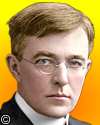 On 31 Jan 1881, Irving Langmuir was born, an American physical chemist who was awarded the 1932 Nobel Prize for Chemistry. In the Jun 1941 issue of Boys’ Life, Langmuir was featured to tell the Boy Scouts of America readers the value of summer jobs. Also of interest are his biographical remarks of his own boyhood experiences that contributed to his abilities as a research scientist and led to winning a Nobel Prize. Likewise, he also describes what drives his assistant, and gives him outstanding qualities. In the present, his message not only remains true, but is perhaps more urgent. Motivated students can still be recommended to seek a summer job that will challenge their intellectual development. Information students get by themselves is enormously more valuable than that which is taught to them in school. Students need opportunities—outside of school—to research, inquire, reason, get hands-on, explore, be curious and explain the phenomena around them. Students who succeed in these pursuits are the most likely to become the future research scientists and engineers. Teachers may wish to share this article on Irving Langmuir with their students, both boys and girls. On 31 Jan 1881, Irving Langmuir was born, an American physical chemist who was awarded the 1932 Nobel Prize for Chemistry. In the Jun 1941 issue of Boys’ Life, Langmuir was featured to tell the Boy Scouts of America readers the value of summer jobs. Also of interest are his biographical remarks of his own boyhood experiences that contributed to his abilities as a research scientist and led to winning a Nobel Prize. Likewise, he also describes what drives his assistant, and gives him outstanding qualities. In the present, his message not only remains true, but is perhaps more urgent. Motivated students can still be recommended to seek a summer job that will challenge their intellectual development. Information students get by themselves is enormously more valuable than that which is taught to them in school. Students need opportunities—outside of school—to research, inquire, reason, get hands-on, explore, be curious and explain the phenomena around them. Students who succeed in these pursuits are the most likely to become the future research scientists and engineers. Teachers may wish to share this article on Irving Langmuir with their students, both boys and girls. |
 On 31 Jan 1841, Sam Loyd was born, American puzzlemaker whose prolific output includes the famous “15” puzzle - a square tray tray containing 15 square tiles and one space that allows the tiles to be rearranged into a given pattern. Today's Science Store pick is: Mathematical Puzzles of Sam Loyd, by Sam Loyd, editted by Martin Gardner (author of the ‘Mathematical Games’ column in Scientific American), who describes Loyd as “America's greatest puzzlist and an authentic American genius.” This book contains a selection of thought-provoking problems and puzzles from Loyd's Cyclopedia in arithmetic, algebra, speed and distance problems, game theory, counter and sliding block problems. It is available New from $5.20. Used from $0.01. (As of time of writing.). On 31 Jan 1841, Sam Loyd was born, American puzzlemaker whose prolific output includes the famous “15” puzzle - a square tray tray containing 15 square tiles and one space that allows the tiles to be rearranged into a given pattern. Today's Science Store pick is: Mathematical Puzzles of Sam Loyd, by Sam Loyd, editted by Martin Gardner (author of the ‘Mathematical Games’ column in Scientific American), who describes Loyd as “America's greatest puzzlist and an authentic American genius.” This book contains a selection of thought-provoking problems and puzzles from Loyd's Cyclopedia in arithmetic, algebra, speed and distance problems, game theory, counter and sliding block problems. It is available New from $5.20. Used from $0.01. (As of time of writing.). | | For picks from earlier newsletters, see the Today in Science History Science Store home page. | |
 | Train yourselves. Don't wait to be fed knowledge out of a book. Get out and seek it. Make explorations. Do your own research work. Train your hands and your mind. Become curious. Invent your own problems and solve them. You can see things going on all about you. Inquire into them. Seek out answers to your own questions. There are many phenomena going on in nature the explanation of which cannot be found in books. Find out why these phenomena take place. Information a boy gets by himself is enormously more valuable than that which is taught to him in school. - Irving Langmuir, American physical chemist (born 31 Jan 1881).  |
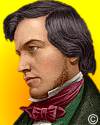 | There are few substance to which it yields interest, when it is considered how very intimately the knowledge and properties and uses of iron is connected with human civilization. - George Fownes, English chemist (died 31 Jan 1849).  |
| Before you look at today's web page, see if you can answer some of these questions about the events that happened on this day. Some of the names are very familiar. Others will likely stump you. Tickle your curiosity with these questions, then check your answers on today's web page. |
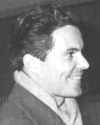 | Rudolf Ludwig M�ssbauer, born 31 Jan 1929, is a German physicist and co-winner of the Nobel Prize for Physics in 1961 for his researches on the M�ssbauer effect which concerns certain emissions from nuclei of radioactive isotopes.
 With what type of emissions is the M�ssbauer effect concerned? |
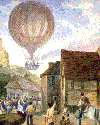 | Charles Green, born 31 Jan 1785, was an English balloonist whose outstanding achievement was his flight with two companions in 1836 from Vauxhall Gardens, London, to Weilburg, Germany, a distance of 480 miles. Green�s 18-hour trip set a long-distance balloon record for flights from England not beaten for many years
 Until what decade did the 1836 record remain unbroken for balloon flights from England? |
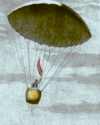 | On 31 Jan 1769, Andr�-Jacques Garnerin was born, a French aeronaut who was the first person to use a parachute regularly and successfully. For his first jump, at age 28, he dropped from a hot-air balloon at 3000 feet. His parachute was semi-rigid, somewhat resembling an umbrella, and it shook back and forth violently during the fall.
 What design change was needed to provide a smoother descent? |
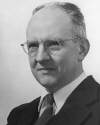 | Dirk Brouwer (1902-1966) was a Dutch-American astronomer and geophysicist known for his achievements in celestial mechanics, especially for his pioneering application of high-speed digital computers for astronomical computations. While still a student he determined the mass of Titan from its influence on other moons of its planet.
 Titan is a moon of which planet? |
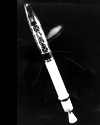 | On 31 Jan 1958, the United States entered the space age by launching the first successful orbiting satellite, four months after the Soviet launch of Sputnik. It measured cosmic radiation, and led to the discovery of the Van Allen radiation belt.
 What was the name of this first successful American satellite to enter Earth orbit? |
| On 31 Jan 1961, the U.S. launched a Mercury-Redstone 2 rocket into suborbital flight carrying a certain animal to test the capabilities of the Mercury capsule. It was retrieved safely, and the American space program was one step closer to the launch of Alan Shepard, the first Mercury astronaut.
 What animal was used in the American Jan 1961 suborbital flight test? |
When you have your answers ready to all the questions above, you'll find all the information to check them, and more, on the January 31 web page of Today in Science History. Or, try this link first for just the brief answers.
Fast answers for the previous newsletter for January 30: yellow fever • computer mouse • transistor • Kitty Hawk, for 12 seconds • cyanoacrylate-based glue such as Crazy Glue. • Variation of Animals and Plants under Domestication • lifeboat. |
 If you enjoy this newsletter, the website, or wish to offer encouragement or ideas, please send feedback by using your mail reader Reply button. If you enjoy this newsletter, the website, or wish to offer encouragement or ideas, please send feedback by using your mail reader Reply button.
Your click on a StumbleUpon, Google+ or Facebook social button on the site webpages is also a welcome sign of appreciation. Thank you for using them. |
To find citations for quotations go to the corresponding webpage by clicking on the “quotes” balloon icon. Sources for the thumbnails appear on today's webpage with the corresponding item.
� This newsletter is copyright 2014 by todayinsci.com. Please respect the Webmaster's wishes and do not put copies online of the Newsletter � or any Today in Science History webpage. (If you already have done so, please remove them. Thank you.) Offline use in education is encouraged such as a printout on a bulletin board, or projected for classroom viewing. Online, descriptive links to our pages are welcomed, as these will provide a reader with the most recent revisions, additions and/or corrections of a webpage. For any other copyright questions, please contact the Webmaster by using your mail reader Reply button. |
--
If you do not want to receive any more newsletters,
Unsubscribe To update your preferences and to unsubscribe visit
this link 


 On 31 Jan 1881, Irving Langmuir was born, an American physical chemist who was awarded the 1932 Nobel Prize for Chemistry. In the Jun 1941 issue of Boys’ Life, Langmuir was featured to tell the Boy Scouts of America readers the value of summer jobs. Also of interest are his biographical remarks of his own boyhood experiences that contributed to his abilities as a research scientist and led to winning a Nobel Prize. Likewise, he also describes what drives his assistant, and gives him outstanding qualities. In the present, his message not only remains true, but is perhaps more urgent. Motivated students can still be recommended to seek a summer job that will challenge their intellectual development. Information students get by themselves is enormously more valuable than that which is taught to them in school. Students need opportunities—outside of school—to research, inquire, reason, get hands-on, explore, be curious and explain the phenomena around them. Students who succeed in these pursuits are the most likely to become the future research scientists and engineers. Teachers may wish to share this article on Irving Langmuir with their students, both boys and girls.
On 31 Jan 1881, Irving Langmuir was born, an American physical chemist who was awarded the 1932 Nobel Prize for Chemistry. In the Jun 1941 issue of Boys’ Life, Langmuir was featured to tell the Boy Scouts of America readers the value of summer jobs. Also of interest are his biographical remarks of his own boyhood experiences that contributed to his abilities as a research scientist and led to winning a Nobel Prize. Likewise, he also describes what drives his assistant, and gives him outstanding qualities. In the present, his message not only remains true, but is perhaps more urgent. Motivated students can still be recommended to seek a summer job that will challenge their intellectual development. Information students get by themselves is enormously more valuable than that which is taught to them in school. Students need opportunities—outside of school—to research, inquire, reason, get hands-on, explore, be curious and explain the phenomena around them. Students who succeed in these pursuits are the most likely to become the future research scientists and engineers. Teachers may wish to share this article on Irving Langmuir with their students, both boys and girls. 


 With what type of emissions is the M�ssbauer effect concerned?
With what type of emissions is the M�ssbauer effect concerned? 
 Until what decade did the 1836 record remain unbroken for balloon flights from England?
Until what decade did the 1836 record remain unbroken for balloon flights from England? 
 What design change was needed to provide a smoother descent?
What design change was needed to provide a smoother descent? 
 Titan is a moon of which planet?
Titan is a moon of which planet? 
 What was the name of this first successful American satellite to enter Earth orbit?
What was the name of this first successful American satellite to enter Earth orbit?  What animal was used in the American Jan 1961 suborbital flight test?
What animal was used in the American Jan 1961 suborbital flight test?  If you enjoy this newsletter, the website, or wish to offer encouragement or ideas, please send feedback by using your mail reader Reply button.
If you enjoy this newsletter, the website, or wish to offer encouragement or ideas, please send feedback by using your mail reader Reply button. 

Δεν υπάρχουν σχόλια:
Δημοσίευση σχολίου